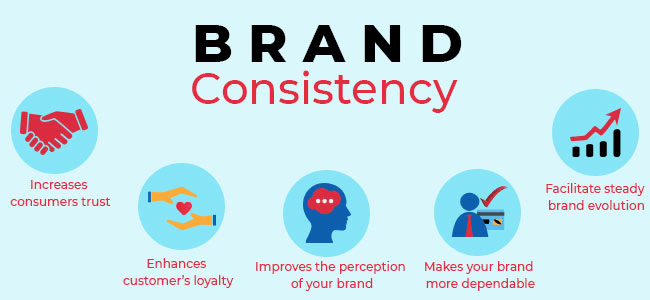In today’s fast-paced digital world, where consumers are bombarded with countless messages and choices, establishing a strong brand identity is crucial for businesses of all sizes. One of the most vital aspects of successful branding is consistency. This blog will explore the importance of consistency in branding, its impact on consumer perception, and strategies for maintaining a cohesive brand image across various platforms.

1. Building Brand Recognition
Consistency in branding fosters recognition. When a brand uses the same colors, logos, fonts, and messaging across all platforms—whether it’s on social media, the company website, or print materials—consumers are more likely to remember it. This recognition is key to establishing a strong brand presence in a crowded marketplace. Over time, consistent branding helps to create a mental association between your brand and its values, products, or services.
Example:
Consider the iconic red and white color scheme of Coca-Cola. No matter where you encounter their products, the consistent branding instantly evokes the brand’s identity and values, making it recognizable worldwide.
2. Building Trust and Credibility
Consumers tend to trust brands that present themselves consistently. When your branding is uniform across all channels, it demonstrates professionalism and reliability. Inconsistent branding can create confusion and lead consumers to question the integrity of your business. By maintaining consistency, you convey a message of stability and dependability, which can significantly influence purchasing decisions.
Example:
If a tech company has a sleek, modern logo and a professional website but uses casual language and amateur graphics in their social media posts, it can create a disconnect. Consumers might question the quality of the tech products offered, affecting their trust in the brand.
3. Enhancing Customer Experience
A consistent brand experience helps to create a cohesive journey for customers, from the first point of contact to post-purchase interactions. When customers know what to expect from your brand—whether in tone, style, or quality—they are more likely to feel comfortable engaging with it. This consistency can lead to increased customer loyalty, as consumers are drawn to brands that provide a reliable experience.
Example:
Apple is a prime example of consistent branding. From their advertising campaigns to the design of their products and even customer service interactions, Apple maintains a premium and minimalist aesthetic. This consistency creates a seamless experience for consumers, reinforcing their loyalty to the brand.
4. Differentiating Your Brand
In a competitive market, consistency helps differentiate your brand from the competition. When your messaging and visual identity are uniform, it becomes easier for consumers to recognize what sets your brand apart. This differentiation is especially important in saturated markets where consumers have numerous choices.
Example:
Nike’s “Just Do It” slogan, along with its signature swoosh logo, is consistently presented in their marketing materials, from advertisements to social media campaigns. This consistent messaging helps establish Nike’s brand identity as one that inspires and empowers, distinguishing it from other athletic brands.
5. Facilitating Marketing Efforts
Consistency in branding simplifies your marketing efforts. When you have a clear brand identity and guidelines, it becomes easier to create marketing materials, campaigns, and strategies that align with your brand’s core values. This streamlined approach can save time and resources while ensuring that your branding remains coherent across all channels.
Example:
Creating a brand style guide that outlines your brand’s colors, typography, tone of voice, and visual elements can help team members stay aligned in their marketing efforts, ensuring all materials maintain a consistent look and feel.
6. Adapting to Change
While consistency is key, it’s also essential to remain adaptable in response to changing market trends and consumer preferences. This doesn’t mean abandoning your core brand identity but rather finding ways to evolve while maintaining the essence of your brand. A successful rebranding or adaptation should reflect your brand’s values while appealing to the evolving needs of your audience.
Example:
Brands like Starbucks have successfully updated their branding over time without losing their core identity. By evolving their logo and expanding their product offerings while maintaining the same focus on quality and customer experience, Starbucks has managed to stay relevant in a changing market.
Conclusion
Consistency in branding is not just about using the same logo or colors; it encompasses the entire customer experience. From brand messaging to visual identity, maintaining consistency builds recognition, fosters trust, enhances customer experiences, and differentiates your brand in a competitive market.


No responses yet